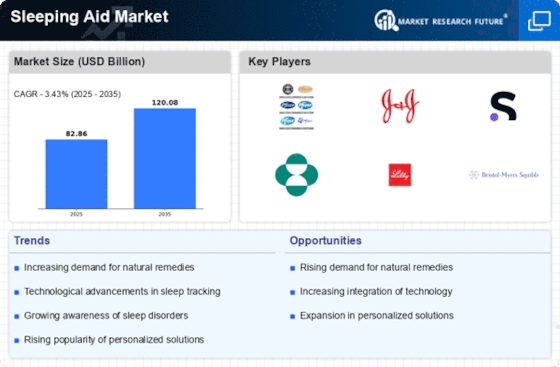Growing Demand for Sleep Solutions
The Sleeping Aid Market is experiencing a notable increase in demand for effective sleep solutions. This trend is driven by a rising awareness of the importance of sleep for overall health and well-being. According to recent data, approximately 30 percent of adults report experiencing sleep disturbances, which has led to a surge in the consumption of sleep aids. As consumers seek remedies for insomnia and other sleep-related issues, the market for sleeping aids is projected to expand significantly. This growth is further fueled by the increasing prevalence of sleep disorders, which affects millions worldwide. Consequently, manufacturers are innovating and diversifying their product offerings to cater to this burgeoning demand, thereby enhancing their market presence.
Aging Population and Sleep Disorders
The Sleeping Aid Market is significantly impacted by the aging population, which is more susceptible to sleep disorders. As individuals age, they often experience changes in sleep patterns and an increased incidence of conditions such as insomnia and sleep apnea. Current demographic data indicates that the population aged 65 and older is projected to double in the coming decades, leading to a corresponding rise in the demand for sleeping aids. This demographic shift presents a substantial opportunity for manufacturers to develop targeted products that cater to the unique needs of older adults. Additionally, healthcare providers are increasingly recommending sleeping aids as part of comprehensive treatment plans for sleep disorders in this age group. Thus, the Sleeping Aid Market is poised for growth as it adapts to the needs of an aging population.
Shift Towards Natural and Herbal Products
The Sleeping Aid Market is witnessing a pronounced shift towards natural and herbal products. Consumers are increasingly inclined to seek alternatives to synthetic medications, driven by concerns over side effects and dependency. This trend is reflected in the growing popularity of herbal supplements, such as valerian root and chamomile, which are perceived as safer options. Market data indicates that the segment of natural sleep aids is expanding at a rapid pace, with sales projected to rise by over 15 percent annually. This shift not only aligns with consumer preferences for holistic health solutions but also encourages manufacturers to invest in research and development of natural formulations. As a result, the Sleeping Aid Market is likely to see a diversification of products that cater to this demand for natural remedies.
Technological Advancements in Sleep Monitoring
The Sleeping Aid Market is being significantly influenced by technological advancements in sleep monitoring devices. Innovations such as wearable technology and smart home devices are enabling consumers to track their sleep patterns more effectively. This data-driven approach allows individuals to identify sleep issues and seek appropriate solutions, thereby driving the demand for sleeping aids. Recent statistics suggest that the market for sleep technology is expected to grow by approximately 20 percent over the next five years. As consumers become more tech-savvy, the integration of sleep monitoring with sleeping aids is likely to enhance user experience and effectiveness. Consequently, manufacturers are increasingly focusing on developing products that incorporate these technologies, thereby positioning themselves competitively within the Sleeping Aid Market.
Rising Stress Levels and Mental Health Awareness
The Sleeping Aid Market is experiencing growth due to rising stress levels and heightened awareness of mental health issues. As individuals face increasing pressures from work and personal life, the prevalence of anxiety and stress-related sleep disorders is on the rise. Recent surveys indicate that nearly 40 percent of adults report sleep problems linked to stress. This growing recognition of the connection between mental health and sleep has led to an increased demand for sleeping aids that address these specific concerns. Manufacturers are responding by developing products that not only promote sleep but also support relaxation and stress relief. This trend is likely to continue, as consumers increasingly prioritize mental well-being, thereby driving the Sleeping Aid Market forward.


















Leave a Comment